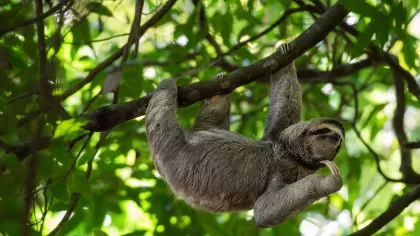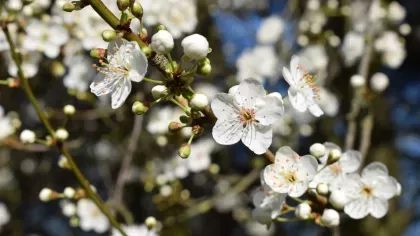25 February 2022
Quiz: Sounds of Costa Rica
Can you tell which animal makes each sound?

Costa Rica is one of the most biodiverse countries in the world — it is chock-full of incredible animals and plants, thriving in its forests and coastlines.
The Costa Rican soundscape at our orchid festival transports visitors to the country’s verdant landscape and features many of the creatures that can be found there.
Turn your speakers up and see if you can guess which animal makes each sound.
1. Which animal makes this noise?
A) Volcano junco (Junco volcano)
B) Fiery-billed aracari (Pteroglossus frantzii)
C) Kinkajou (Potos flavus)
D) Black-faced solitaire (Myadestes melanops)




2. Which animal makes this noise?
A) Black guan (Chamaepetes unicolor)
B) Montezuma’s oropendola (Psarocolius montezuma)
C) Three-wattled bell bird (Procnias tricarunculatus)
D) Bairds trogon (Trogon bairdii)




3. Which animal makes this noise?
A) Tropical screech owl (Megascops choliba)
B) Grey fox (Urocyon cinereoargenteus)
C) Howler monkey (Alouatta palliata)
D) Crocodile (Crocodylus acutus)




4. Which animal makes this noise?
A) Leafcutter ants (Atta cephalotes)
B) Purple gallinule (Porphyrio martinica)
C) Magnificent frigatebird (Fregata magnificens)
D) Red-winged grasshopper (Oedipoda germanica)




5. Which animal makes this noise?
A) Squirrel cuckoo (Piaya cayana)
B) Resplendent quetzal (Pharomachrus mocinno)
C) Northern potoo (Nyctibius jamaicensis)
D) Masked duck (Nomonyx dominicus)




Answers
1. D) Black-faced solitaire (Myadestes melanops)
This thrush is known for its beautiful flutey song, which can be heard drifting over montane forests in Costa Rica.
Its diet mainly consists of berries, though it also eats insects.
The black-faced solitaire has such a nice voice that sadly many are captured as pets, but their main threat is loss of habitat through deforestation.
2. B) Montezuma's oropendola (Psarocolius montezuma)
Named to commemorate the Aztec Emperor Montezuma II, the Montezuma oropendola is an unforgettable bird.
Males make unique calls, often accompanied by a bowing dance in a bid to impress potential mates.
Females create intricate, long (60-180cm) pendular nests in tall trees to protect young from predators. There can be up to 150 nests in a single tree.
3. C) Howler monkey (Alouatta palliata)
The howler monkey is believed to be the loudest land animal, with a cry that can be heard three miles away!
They live between 15 and 20 years in large social groups of 6 to 15 individuals.
Vocalisations form an important part of howler monkeys’ social structure: signalling occupied territory, attracting mates, and protecting individuals or troop members.
This monkey’s deep, guttural howls are mostly heard at dawn and dusk: one of the creatures starts the cry then the others join in — a very different dawn chorus than that heard at Kew!
4. A) Leafcutter ants (Atta cephalotes)
Known in Costa Rica as ‘zompopas’, leafcutter ants can carry up to 50 times their body weight in their jaws!
These ants are farmers, cutting leaves with their special saw-like jaws that vibrate a thousand times a second, which produces the sound in this clip.
The leafcutter ants don’t eat the leaves – they take them to the colony, chew them up and cultivate a fungus garden from the mulch which feeds the nest.
Did you know? The largest leafcutter ant nests can cover up to 6,500 square feet – that's about twice the size of The Orangery's floor space!
5. B) Resplendent quetzal (Pharomachrus mocinno)
Quetzal means precious or sacred in many Mesoamerican languages, so it may be no surprise that the resplendent quetzal bird is considered one of the most beautiful in the world.
It is vibrantly-coloured. Whilst it looks green due to stripes of melanin pigment in its feathers, the resplendent quetzal is in fact brown.
In the mating season, male resplendent quetzals grow twin tail feathers that can be up to one metre long. Their tail plays an important part in mating rituals, as they perform a twirling dance above females.
Your score
Tally up your score out of 5 to see if you've got a good ear...
4+: ¡Bien huecho! You’re all ears!
2 – 3: Muy bien, you’d be great on a sound safari.
1: Mala suerte. May be time to turn up the volume?
0: ¡Abismal! Time to clean your ears.
Let us know how you did on our Facebook, Twitter or Instagram.
Audio 1 © Alex Monro, RBG Kew. Myadestes.
Audio 2 © Alex Monro (2010), RBG Kew. Montezuma's oropendola.
Audio 3 © AdrianBoSa (2020). Mantled howler monkey (Alouatta palliata). Biosounds. Tortuga Beach Reserve - Ojochal de Osa, Costa Rica
Audio 4 © Connor Schon (2020). The sounds of leafcutter ants (Atta cephalotes). YouTube. Montshire Museum of Science, Norwich, VT.
Audio 5 © David L. Ross (1991). Resplendent quetzal (Pharomachrus mocinno). Macaulay Library at the Cornell Lab of Ornithology. Monteverde Cloud Forest Reserve, Puntarenas, Costa Rica.



